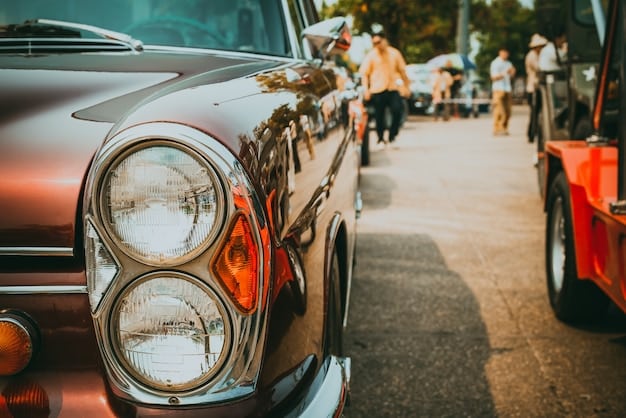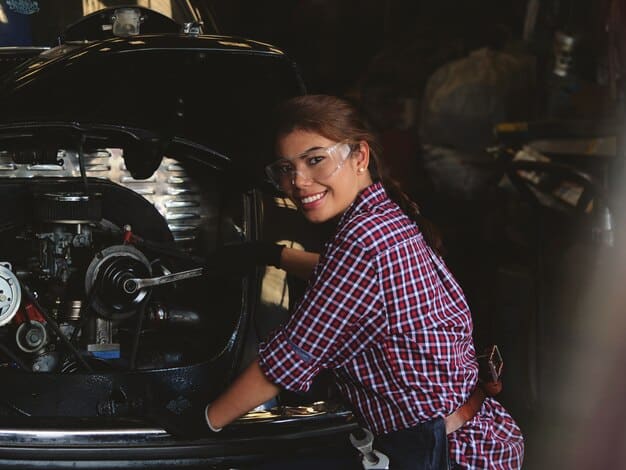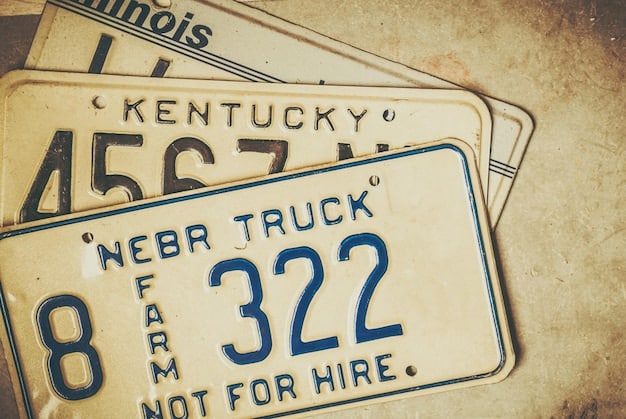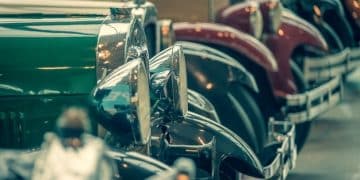The Culture of Automotive Collecting: Building Your Dream Car Collection

The culture of automotive collecting involves passionate enthusiasts who acquire, preserve, and curate vehicles as investments, historical artifacts, and expressions of personal taste, contributing to a vibrant community and driving the classic car market.
The allure of automobiles transcends mere transportation; for many, it evolves into a passion, a hobby, and even an obsession. The culture of automotive collecting is a rich tapestry woven with threads of history, engineering, art, and personal aspiration. Building and curating a dream car collection is an endeavor that combines meticulous planning, deep knowledge, and a profound appreciation for automotive excellence.
Understanding the Automotive Collecting Landscape
Automotive collecting is more than just owning a fleet of vehicles; it’s about understanding the market, appreciating the history, and knowing how to maintain and preserve these mechanical masterpieces. This section delves into the key aspects of the automotive collecting landscape, providing insights into what drives this culture.
The automotive collecting landscape is diverse and ever-changing, influenced by economic trends, technological advancements, and shifts in collector preferences. Understanding these elements is crucial for anyone looking to seriously engage in this culture. Let’s explore the fundamental aspects that shape the automotive collecting world.
Market Dynamics and Trends
The automotive collecting market is influenced by various factors, including rarity, condition, historical significance, and provenance. Trends in collector preferences can also significantly impact the value of certain models. For example, there has been a surge in interest in 1980s and 1990s sports cars in recent years.
The Psychology of Collecting
For many collectors, owning a classic car is more than just an investment; it’s an emotional connection to a bygone era. The thrill of the chase, the satisfaction of restoration, and the pride of ownership are all key components of the collecting experience. Understanding the psychological drivers behind collecting helps to appreciate the depth of this culture.
- Nostalgia: Vehicles often trigger memories and emotions related to specific periods.
- Status: Owning rare or historically significant vehicles can enhance social standing.
- Investment: Classic cars can be a tangible asset that appreciates over time.
- Personal Fulfillment: Collecting provides a creative outlet and a sense of accomplishment.
In conclusion, the automotive collecting landscape is a multifaceted world characterized by market dynamics, psychological drivers, and a deep appreciation for automotive history. Grasping these elements is crucial for anyone aspiring to build and curate a meaningful car collection.
Defining Your Automotive Collecting Goals
Before embarking on the journey of automotive collecting, it’s essential to define your goals. What do you hope to achieve with your collection? Are you interested in preservation, investment, personal enjoyment, or a combination of these? Understanding your objectives will guide your choices and ensure a fulfilling collecting experience.
Defining your automotive collecting goals is the cornerstone of building a successful and personally rewarding collection. This involves determining your motivations, interests, budget, and long-term aspirations. Here’s a more detailed exploration of how to define those goals effectively.
Identifying Your Interests
What types of cars resonate with you the most? Are you drawn to sports cars, vintage vehicles, muscle cars, or modern supercars? Identifying your interests will help you narrow down your focus and build a collection that truly excites you.
Setting a Budget
Automotive collecting can be an expensive hobby, so it’s crucial to establish a realistic budget early on. Consider not only the purchase price of the vehicles but also the costs of maintenance, storage, insurance, and restoration. A well-defined budget will help you make informed decisions and avoid financial strain.

- Purchase Price: Research current market values for desired models.
- Maintenance: Factor in regular servicing and potential repairs.
- Storage: Consider the cost of a secure and climate-controlled garage.
- Insurance: Obtain adequate coverage to protect your investment.
Ultimately, defining your automotive collecting goals involves aligning your passion with practical considerations. By identifying your interests, setting a budget, aligning your collection with your lifestyle, and setting achievable long-term goals, you can create a collection that brings you joy and satisfaction for years to come.
Researching and Sourcing Your Dream Cars
Once you have a clear idea of your collecting goals, the next step is to begin researching and sourcing your dream cars. This requires patience, diligence, and a keen eye for detail. Knowing where to look and what to look for can make all the difference in finding the perfect addition to your collection.
Researching and sourcing your dream cars is a critical phase in automotive collecting. This process transforms your collecting goals into tangible acquisitions. Here’s how to effectively research and source vehicles that align with your aspirations.
Online Marketplaces
Online marketplaces such as Hemmings, ClassicCars.com, and Bring a Trailer are excellent resources for finding classic and collectible cars. These platforms offer a wide selection, detailed descriptions, and often, auction formats that can provide opportunities for securing vehicles at competitive prices.
Auctions and Events
Attending auctions and automotive events can provide unique opportunities to discover rare and desirable cars. Events like Barrett-Jackson, RM Sotheby’s, and local car shows offer a chance to see vehicles in person, network with other collectors, and bid on cars directly.
- Local Car Shows: Offer a close-up view of vehicles and networking opportunities.
- Specialized Auctions: Provide access to high-end collectibles.
- Private Sales: Can sometimes offer better deals and more personalized service.
In conclusion, researching and sourcing your dream cars requires a multifaceted approach. By leveraging online resources, attending auctions and events, engaging with collector communities, and enlisting the expertise of professionals, you can enhance your chances of finding and acquiring the vehicles that will make your collection truly exceptional.
Evaluating Condition and Authenticity
Before making a purchase, it’s essential to thoroughly evaluate the condition and authenticity of the vehicle. A car may look great on the surface, but hidden issues can turn your dream into a nightmare. This section covers the key areas to inspect and the steps to verify a car’s history and originality.
Evaluating the condition and authenticity of a vehicle is paramount in automotive collecting. A meticulous assessment protects your investment and ensures you’re acquiring a piece of automotive history as represented. Here’s a detailed guide on what to look for and how to verify a car’s true nature.
Checking for Rust and Corrosion
Rust and corrosion are the silent killers of classic cars. Pay close attention to vulnerable areas such as wheel wells, rocker panels, and floorboards. Look for signs of bubbling paint, surface rust, and structural damage. A thorough inspection can reveal potential problems that may require costly repairs.
Verifying Originality
Originality is a key factor in the value of a classic car. Check the vehicle’s VIN (Vehicle Identification Number) and compare it to factory records to verify its build specifications. Inspect the engine, transmission, and other major components to ensure they match the original equipment.

- VIN Verification: Confirm the VIN matches the vehicle’s documentation.
- Factory Records: Research original build sheets and specifications.
- Component Matching: Ensure major components are period-correct.
- Expert Appraisal: Seek professional evaluations for authentication.
In conclusion, evaluating condition and authenticity requires patience, attention to detail, and a commitment to thorough investigation. By checking for rust, verifying originality, assessing mechanical condition, examining paperwork, and seeking professional opinions, you can confidently acquire vehicles that enhance your collection and retain their value over time.
Maintaining and Preserving Your Collection
Owning a collection of classic cars is just the beginning. Maintaining and preserving these vehicles requires ongoing effort and attention. This section provides practical tips on how to keep your collection in top condition, from routine maintenance to long-term storage strategies.
Maintaining and preserving your automotive collection is essential for protecting your investment and ensuring these vehicles remain in pristine condition for future generations. This involves regular care, proper storage, and a proactive approach to addressing potential issues.
Routine Maintenance
Regular maintenance is crucial for keeping your cars running smoothly. This includes oil changes, fluid checks, tire rotations, and brake inspections. Following the manufacturer’s recommended maintenance schedule can help prevent major problems and extend the life of your vehicles.
Proper Storage Techniques
Proper storage is essential for preserving your cars when they’re not in use. Store your vehicles in a clean, dry, and climate-controlled environment. Use car covers to protect the paint from dust and scratches. Consider using battery tender to prevent battery drain during long periods of storage.
In conclusion, maintaining and preserving your collection involves a proactive and diligent approach. By implementing a routine maintenance schedule, utilizing proper storage techniques, addressing issues promptly, and documenting your efforts, you can ensure your vehicles remain in excellent condition, preserving their value and enjoyment for years to come.
Engaging with the Automotive Collecting Community
The culture of automotive collecting is enriched by the community of enthusiasts who share a passion for cars. Engaging with this community can provide valuable insights, networking opportunities, and a sense of camaraderie. This section explores the various ways to connect with fellow collectors and expand your knowledge.
Engaging with the automotive collecting community enhances your experience, providing a wealth of knowledge, networking opportunities, and camaraderie. This engagement can range from attending local car meets to participating in international events, enriching your collecting journey.
Joining Car Clubs
Car clubs are a great way to connect with other collectors who share your interests. Whether it’s a club dedicated to a specific marque or a general classic car organization, these groups offer opportunities to attend events, participate in rallies, and share knowledge.
Attending Automotive Events
Attending automotive events such as car shows, auctions, and vintage races can provide opportunities to meet other collectors, see rare cars, and learn about the latest trends in the market. These events also offer a chance to showcase your own vehicles and receive valuable feedback.
- Networking: Connect with other collectors and industry experts.
- Learning: Gain insights into market trends and vehicle maintenance.
- Exhibiting: Showcase your vehicles and receive feedback.
In conclusion, engaging with the automotive collecting community elevates your passion and knowledge. By joining car clubs, attending automotive events, using social media and online forums, and contributing to the community, you can build lasting relationships, expand your expertise, and enhance the overall enjoyment of your collecting journey.
| Key Point | Brief Description |
|---|---|
| 🏁 Setting Goals | Define interests and budget for focused collecting. |
| 🔍 Research | Utilize online resources and auctions to find cars. |
| 🛠️ Maintenance | Regular care and proper storage are critical. |
| 🤝 Community | Engage with clubs for shared knowledge. |
Frequently Asked Questions
▼
A collectible car typically stands out due to its rarity, historical significance, design, or technological innovation. Models with low production numbers, unique features, or a strong racing heritage often become highly sought after by collectors.
▼
Originality profoundly impacts value. Cars with original parts, paint, and interior command higher prices. Collectors often seek vehicles that reflect their factory condition, making originality a significant aspect of evaluation, preservation, and the overall appeal.
▼
Ongoing costs include insurance, storage, regular maintenance, and unexpected repairs. Climate-controlled storage, specialized parts, and professional servicing can also add to the expense. Budgeting these costs is essential for sustainable collecting.
▼
Top sourcing options include online marketplaces, auctions, car shows, and private sales. Websites specializing in classic cars offer numerous listings, while auctions offer competitive bidding. Networking at car shows can unveil potential leads for acquisitions.
▼
Preserve originality, ensure regular maintenance, and store cars in climate-controlled spaces. Keep comprehensive records of repairs and provenance, and engage with collector communities. These steps help preserve value and ensure long-term appeal of the collection.
Conclusion
Building and curating a dream car collection is an ambitious yet rewarding endeavor that blends passion, knowledge, and strategy. By defining clear goals, researching diligently, preserving authenticity, implementing proactive maintenance, and actively engaging with the automotive community, enthusiasts can create collections that bring immense personal satisfaction and stand the test of time.





